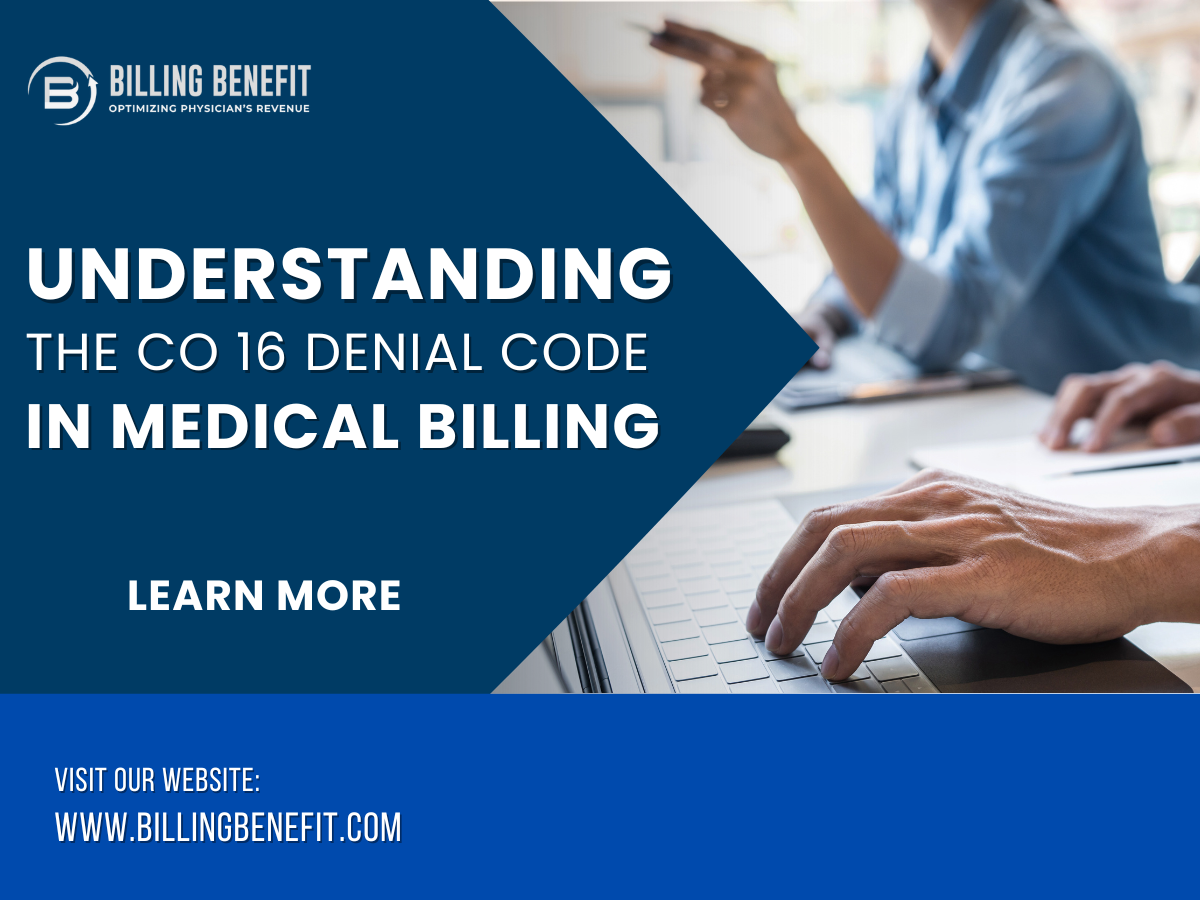Medical billing is a highly technical and detail-oriented process, and denial codes like the CO 16 denial code play an essential role in signaling issues with submitted claims. When a healthcare provider submits a claim to an insurance company, any errors or missing information can trigger a denial. The CO 16 denial code specifically alerts the provider that the claim lacks necessary information for processing.
This denial is categorized as a Contractual Obligation (CO) denial, meaning the insurance company will not pay for the claim due to incomplete or incorrect details. This issue is often frustrating because the CO 16 denial code doesn’t always explain precisely what is wrong, making it important for providers to carefully review all aspects of the claim. Let’s delve into the meaning, causes, and strategies to prevent and resolve CO 16 denials in medical billing.
What Does CO 16 Denial Code Mean?
The CO 16 denial code is a general notification that the claim submitted lacks critical information necessary for adjudication. This could range from missing patient demographic details to incorrect procedure codes or incomplete documentation supporting the service billed. Essentially, the insurance payer is unable to process the claim without receiving the correct or full information from the provider.
This denial code is often paired with Remittance Advice Remark Codes (RARCs), which provide additional clarification on the exact reason for the denial. For example, the RARC M16 indicates missing documentation, while RARC M51 signals missing procedure codes. By understanding the combination of these codes, healthcare providers can better pinpoint the issue and take corrective action.
Common Causes of CO 16 Denial Code
The CO 16 denial code can be triggered by several different issues. Some of the most common reasons include:
1. Missing Information
Claims that are incomplete or have blank fields can easily trigger a CO 16 denial. Examples include:
- Missing patient details, such as name, date of birth, or insurance ID.
- Provider information, such as address or National Provider Identifier (NPI).
- Missing diagnosis or procedure codes.
2. Incorrect Coding
Another frequent reason for CO 16 denials is the use of incorrect or outdated procedure or diagnosis codes. Even a small typo or using a previous version of a code can lead to a rejection.
3. Prior Authorization Issues
Certain services or procedures may require prior authorization from the insurance company. If the provider performs a service without obtaining this approval beforehand, the claim can be denied.
4. Insurance Eligibility Issues
Sometimes, the patient’s insurance plan may not cover the service in question, or they may have exceeded their coverage limits. These eligibility issues can lead to a CO 16 denial as well.
Impact of CO 16 Denials on Healthcare Providers
The CO 16 denial code can have a significant impact on a healthcare provider’s revenue cycle. Denied claims lead to delays in payments and can strain the cash flow of a medical practice. Providers need to allocate more administrative resources to identify and correct the errors, re-submit the claim, and then wait again for adjudication. This process increases the operational burden and can be particularly costly for small practices.
How to Prevent CO 16 Denials Code
To avoid the CO 16 denial code, healthcare providers need to focus on improving the accuracy and completeness of their claim submissions. Below are some key strategies to reduce these denials:
1. Double-Check Claim Information
Before submitting a claim, it’s essential to thoroughly review all the information, including patient demographics, provider details, and procedure codes. This can prevent many of the common errors that lead to CO 16 denials.
2. Use Claim Scrubbing Software
Many healthcare providers now rely on claim scrubbing software that automatically checks for missing or incorrect information before submission. This software flags potential issues, such as missing modifiers or invalid patient data, allowing billing staff to correct errors upfront.
3. Regular Staff Training
It’s crucial to keep billing and coding staff up to date on the latest coding guidelines and payer requirements. Comprehensive training helps ensure that staff members can accurately code and submit claims, reducing the likelihood of denials.
4. Submit Claims Electronically
Electronic claim submission reduces errors associated with manual paper submissions. Electronic systems also provide real-time validation, alerting the provider to missing or incorrect information before submission.
5. Conduct Internal Audits
Regular internal audits can help identify patterns in claim denials. By tracking the reasons behind denials, healthcare providers can adjust their processes to prevent future errors.
How to Resolve CO 16 Denials Code
If a claim is denied with the CO 16 denial code, follow these steps to resolve the issue:
1. Review the Remarks Code
The CO 16 denial code usually comes with an associated RARC. These remark codes help explain the specific reason for the denial, such as missing documentation or invalid procedure codes. Review these codes carefully to determine the exact cause of the denial.
2. Correct the Error
Once the issue has been identified, correct the error. This may involve updating the patient information, including missing documents, or correcting the coding errors. Ensure that all necessary details are filled out accurately before resubmitting the claim.
3. Submit an Appeal
In some cases, the payer may still deny the corrected claim. If this happens, it is important to submit a formal appeal. The appeal should include supporting documentation to justify the medical necessity of the service or to clarify the error in the original submission. Be mindful of the payer’s appeal deadline to ensure the claim can be reviewed again.
4. Follow-Up with the Payer
After resubmitting or appealing the claim, maintain open communication with the payer. Follow up regularly to ensure that the claim is being processed and to address any further issues that may arise.
Conclusion for CO 16 Denial Code
The CO 16 denial code can cause significant delays in reimbursements and impact the financial health of healthcare providers. However, by understanding the common causes behind this denial and implementing preventive strategies like claim scrubbing software and regular staff training, providers can reduce the occurrence of CO 16 denials. When denials do happen, reviewing the remark codes and correcting the errors promptly can help resolve the issue and improve the chances of getting paid faster.
By focusing on accuracy, compliance with payer guidelines, and efficient claim management practices, healthcare providers can significantly reduce the administrative burden and improve their revenue cycle.
FAQs
Q. What is the CO 16 denial code?
A. The CO 16 denial code indicates that the claim submitted by the healthcare provider lacks necessary information or contains incorrect details, preventing the insurance company from processing it.
Q. What are common reasons for CO 16 denials?
A. Common reasons include missing patient or provider information, incorrect coding, lack of prior authorization, and insurance eligibility issues.
Q. How can healthcare providers prevent CO 16 denials?
A. Providers can prevent denials by double-checking claims for accuracy, using claim scrubbing software, providing staff training, submitting claims electronically, and conducting regular internal audits.
Q. What steps should be taken to resolve a CO 16 denial?
A. Review the associated remarks code, correct the error, resubmit the claim, or appeal the denial with proper documentation.
Q. Can CO 16 denials be appealed?
A. Yes, if the corrected claim is still denied, healthcare providers can file an appeal, including supporting documentation to explain the error or justify the medical necessity.
Q. What role does claim scrubbing software play in preventing denials?
A. Claim scrubbing software helps identify and flag errors or missing information before a claim is submitted, reducing the likelihood of denials.










